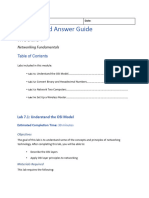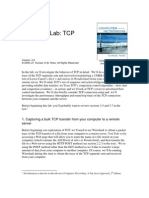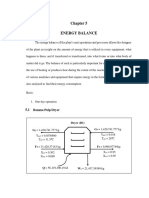Lab01 Exercise
Lab01 Exercise
Uploaded by
jeetendrasidhiCopyright:
Available Formats
Lab01 Exercise
Lab01 Exercise
Uploaded by
jeetendrasidhiOriginal Description:
Copyright
Available Formats
Share this document
Did you find this document useful?
Is this content inappropriate?
Copyright:
Available Formats
Lab01 Exercise
Lab01 Exercise
Uploaded by
jeetendrasidhiCopyright:
Available Formats
Lab01: Overview of Networking Tools
May 5
th
, 2014 : 2 to 5.15 pm
Objective:
1. Get acquainted with some commonly used networking commands and TCP/IP diagnostic tools.
2. Understand the concept of layering/encapsulation by looking at Link, IP and TCP headers.
3. Understand the concept of multiplexing using Ethernet "frame type" field, IP "protocol field",
transport "port number" field.
General instructions
1. This lab is to be done in groups of two.
2. In some of the exercises, I will specify a goal. You job is to design an experiment that meets the
goal, conduct it and answer the questions asked.
3. Create a directory called <remote_center_id1>_<remote_center_id2>_lab01. Open a file lab01.txt
inside the directory using a text editor. As you proceed with the lab instructions below, for each
exercise, note down the answers to the exercise along with any interesting observations in the file.
Take care to ensure that the content in the file is neatly organized.
4. At the end of the lab hours, pair up with another group and exchange your directories. A file with
correct answers will be provided on bodhitree.cse.iitb.ac.in (same place as where you downloaded
the assignment). Please check each others answers against the file and discuss the same for better
understanding.
5. You may want to zip up your directory and email/save it for later reference.
Reference:
1. Man pages of the commands.
2. TCPdump: http://danielmiessler.com/study/tcpdump/
3. Video/Slides of 'OSI Protocol stack' and 'Inter-Layer Communication' under Introduction.
Lab instructions:
Exercise 1: Play Time
Play around with tcpdump, wireshark, ping, arp, route, ifconfig, host
Look at /etc/hostname; /etc/hosts; /etc/network/interfaces; /etc/resolv.conf; /etc/protocols; /etc/services and
understand what the files are for.
At the end of this exercise, you should have some basic understanding of how a host manages network
information as well as gain some experience on using networking tools.
You should be able to collect a trace (write to a file) via tcpdump and view the trace in wireshark (using the
-r option).
Exercise 2: Simple Stuff
1. Whats your machine's host name and IP address? How did you get this information?
2. What is the next hop router's IP address and MAC address? How did you get this information?
3. What is the local DNS server's host name and IP address? How did you get this information?
4. What do the numbers in the file /etc/protocols represent?
5. What is the port number associated with applications: ssh, ftp, nfs, smtp (email)?
Exercise 3: Encapsulation and Demultiplexing
Goal: To understand layering and demultiplexing, Ms. Lux wants to capture packets. She also wants to
understand how web flows operate at the same time. So, help her design an experiment that captures only
those packets that are exchanged between her machine and CSE web server when she clicks the url
http://www.cse.iitb.ac.in/~chebrolu/.
Guidance:
1. Run tcpdump with -n option to avoid name lookup.
2. Use wget (command: wget --no-proxy www.cse.iitb.ac.in/~chebrolu) to download the url. You could
also use firefox/chrome, but this is cleaner and simpler.
3. Your trace should not capture any background traffic.
4. Before answering the questions, explore different packets by clicking on the individual packets. Also
note the sequence of packet exchange.
Report:
1. Explain your experimental design by specifying the exact commands (with options) you will run and
in which order. Avoid description unless absolutely necessary.
2. Select the first TCP packet listed.
a) Which next-hop node is it destined to? Specify the next-hop node's MAC and IP address. How
did you determine this information?
b) Who is the packet's final destination? Specify the final destinations' MAC and IP address? How
did you determine this information?
c) What are the fields used at the link(Ethernet), IP and TCP headers to demux the packet at the
destination? Specify the values of these fields in decimal format and the corresponding process
(protocol) the packet is passed to.
3. Apart from the above reporting, name your trace file as exercise3.out and add the file to your roll-
number directory.
Exercise 4: More DeMultiplexing
Goal: With the success of the previous experiment, Ms. Lux now wants to capture and examine different
types of traffic, basically arp, ICMP (protocol used by ping) and ssh. She wants to capture all of the above in
just one single trace. Help her design an experiment to do the same.
Guidance:
1. For ssh, you could ssh to your neighbor's machine using nsluser or osluser depending on which
location you are in i.e use the same login you used to login to your machine, except set the IP
address to your neighbor's machine (e.g. ssh nsluser@10.105.12.24)
2. In wireshark, click on the protocol field to order the packets according to the protocol.
Report:
1. Explain your experimental design by specifying the exact commands (with options) you will run and
in which order. Avoid description unless absolutely necessary.
2. Arp protocol: Click on any one of the ARP packets.
a) Trace the flow of this packet up the protocol stack i.e specify what all processes/protocols handle
this packet.
b) What is the value of the field used in Ethernet header to pass packets to the ARP module?
Express it in decimal format.
3. ICMP protocol: Click on any one of the ICMP packets.
a) Trace the flow of this packet up the protocol stack i.e specify what all processes handle this
packet.
b) Expand the Ethernet header. Which higher level process (protocol) is this packet passed to and
what is the value in decimals?
c) Expand the IP header. What is the value of the field used in this header to pass packets to the
ICMP module? Express it in decimal format.
4. SSH protocol: Click on any one of the SSH packets.
a) Click on the IP header field. Specify the source and destination IP addresses.
b) Expand the TCP header. Specify the source and destination port numbers.
c) Which machine (IP address) is the SSH server? Hint: SSH server's listen on designated ports as
specified in /etc/services.
5. Name your trace file as exercise4.out and add the file to your roll-number directory.
You might also like
- Packet Sniffing and Spoofing Lab - FinalDocument26 pagesPacket Sniffing and Spoofing Lab - FinalKhalil Ullah67% (3)
- Sniffing SpoofingDocument6 pagesSniffing SpoofingDeTRoyDNo ratings yet
- Effectiveness of Distribution Channel Questionnaire ShodhgangaDocument13 pagesEffectiveness of Distribution Channel Questionnaire Shodhgangaalkanm75083% (6)
- Computer Fundamentals Question Bank Unit-1: Fundamentals of ComputersDocument4 pagesComputer Fundamentals Question Bank Unit-1: Fundamentals of ComputersMr. MANTRA100% (1)
- IPv4 Subnetting for Beginners: Your Complete Guide to Master IP Subnetting in 4 Simple Steps: Computer Networking, #1From EverandIPv4 Subnetting for Beginners: Your Complete Guide to Master IP Subnetting in 4 Simple Steps: Computer Networking, #1Rating: 5 out of 5 stars5/5 (3)
- Lesson 2 Assignment Networking FundamentalsDocument2 pagesLesson 2 Assignment Networking FundamentalsTyler Kristian CourtneyNo ratings yet
- Lab Assignment-1Document4 pagesLab Assignment-1KARAN SHARMANo ratings yet
- 5 Wireshark Ethernet ARP v6.01Document8 pages5 Wireshark Ethernet ARP v6.01Trần Ngọc LâmNo ratings yet
- Wireshark Lab: Ethernet and ARPDocument9 pagesWireshark Lab: Ethernet and ARPmailsanjayhere8362No ratings yet
- 307 Shyam IpDocument15 pages307 Shyam Iprrrlll12345.2010No ratings yet
- Lab 3 - StudentDocument17 pagesLab 3 - StudentsalwaNo ratings yet
- Network BasicsDocument3 pagesNetwork Basicshuyxiem123No ratings yet
- Malik Tcpdump FiltersDocument41 pagesMalik Tcpdump FiltersombidasarNo ratings yet
- Class 9 Data Link LayerDocument5 pagesClass 9 Data Link LayerNurhanNo ratings yet
- Techno India College of Technology: Computer Network Lab Manual Paper Code: CS692Document8 pagesTechno India College of Technology: Computer Network Lab Manual Paper Code: CS692Deep Narayan ChaudhuriNo ratings yet
- Lab3 Wireshark Ethernet ARP v6.01Document8 pagesLab3 Wireshark Ethernet ARP v6.01Alina NedelciuNo ratings yet
- Lab 05Document2 pagesLab 05khanh.minhdoanNo ratings yet
- LAB 5 IP and ICMPDocument5 pagesLAB 5 IP and ICMPParth PatelNo ratings yet
- Wireshark Lab 06Document16 pagesWireshark Lab 06Check OutNo ratings yet
- Pcap LibDocument4 pagesPcap LibB20DCAT088 Lưu Văn HưngNo ratings yet
- 2017 Advanced Computer Networks Homework 1Document6 pages2017 Advanced Computer Networks Homework 1Fadhli RahimNo ratings yet
- Atividade Wireshark - Lab - IPDocument7 pagesAtividade Wireshark - Lab - IPheloiNo ratings yet
- Lab4 COMP4337Document8 pagesLab4 COMP4337k85m8x7jy5No ratings yet
- Wireshark Lab: Ethernet and ARPDocument9 pagesWireshark Lab: Ethernet and ARPSonu ManiNo ratings yet
- PES2UG22CS397CNLABWEEK1Document15 pagesPES2UG22CS397CNLABWEEK1Ashish GuptaNo ratings yet
- Wireshark IP v6.0Document6 pagesWireshark IP v6.0Kuro ShiroNo ratings yet
- Lab-8 W0851889Document27 pagesLab-8 W0851889aryansharma6No ratings yet
- Chapter9 PDFDocument2 pagesChapter9 PDFDinh Phuc BuiNo ratings yet
- MP3Document5 pagesMP3Kapil Kale0% (1)
- Wireshark Arp GayDocument6 pagesWireshark Arp GayyalaboukNo ratings yet
- ManualDocument48 pagesManualKhairul Amin SukriNo ratings yet
- Lab04 EthernetDocument2 pagesLab04 Ethernetkhanh.minhdoanNo ratings yet
- Lablist of CCNDocument8 pagesLablist of CCNBHAVIKA JAINNo ratings yet
- Wireshark LabDocument12 pagesWireshark LabNimesh NaikNo ratings yet
- Lab12 Netw Forensics Data HidingDocument17 pagesLab12 Netw Forensics Data HidingLêDương AnhTuấnNo ratings yet
- Networking - 2 (B1 Jan'23 Batch)Document9 pagesNetworking - 2 (B1 Jan'23 Batch)divakara sNo ratings yet
- CN Lab 2Document8 pagesCN Lab 2Abdul Haseeb SheikhNo ratings yet
- Wireshark TCP Sept 15 2009Document8 pagesWireshark TCP Sept 15 2009Pablo Enrico Carvalho OliveiraNo ratings yet
- Statement Purpose:: CCSXXX Lab ManualDocument7 pagesStatement Purpose:: CCSXXX Lab ManualSaleem IqbalNo ratings yet
- Ethereal Lab: IP: 1. Capturing Packets From An Execution of TracerouteDocument6 pagesEthereal Lab: IP: 1. Capturing Packets From An Execution of TracerouteSafet DacićNo ratings yet
- CN Lab Exp 2 YashDocument7 pagesCN Lab Exp 2 YashTushar SharmaNo ratings yet
- CSE 338 Lab Manual 1Document3 pagesCSE 338 Lab Manual 1Russel PeterNo ratings yet
- Packet Filtering FirewallDocument9 pagesPacket Filtering FirewallEnoch L SNo ratings yet
- Lab 9-10Document6 pagesLab 9-10Anant PatniNo ratings yet
- Wireshark Lab: UDP: Approach, 8 Ed., J.F. Kurose and K.W. RossDocument3 pagesWireshark Lab: UDP: Approach, 8 Ed., J.F. Kurose and K.W. RossTiago SilvaNo ratings yet
- CommNet LabExperimentsDocument12 pagesCommNet LabExperimentsEfka DxNo ratings yet
- 1 APT Portfolio Interview Experience - Set 1 (On-Campus) 2Document6 pages1 APT Portfolio Interview Experience - Set 1 (On-Campus) 2Ajay KumarNo ratings yet
- Assignment On Wireshar1Document4 pagesAssignment On Wireshar1Anonymous zTBOZVNo ratings yet
- Ethereal IPDocument6 pagesEthereal IPmjrbaconNo ratings yet
- Multiple Choice Questions:: 1. How Does CSMA/CD React To Collisions?Document13 pagesMultiple Choice Questions:: 1. How Does CSMA/CD React To Collisions?Franch Maverick Arellano LorillaNo ratings yet
- Lab1 (CNS301)Document9 pagesLab1 (CNS301)qazimahrukh169No ratings yet
- Network Basics 1.1 What Is A Network?Document115 pagesNetwork Basics 1.1 What Is A Network?santhoshmayal_460311No ratings yet
- LabExercise1 EhternetDocument5 pagesLabExercise1 EhternetSyaiful Maulana AbbidinNo ratings yet
- Week 11 - Wireshark Lab 10Document10 pagesWeek 11 - Wireshark Lab 10davaughnNo ratings yet
- A FramesDocument6 pagesA FramesSaman Samuel SimorangkirNo ratings yet
- Computer Networks Lab ManualDocument75 pagesComputer Networks Lab Manualshreekar.nyayapathi23No ratings yet
- The Compete Ccna 200-301 Study Guide: Network Engineering EditionFrom EverandThe Compete Ccna 200-301 Study Guide: Network Engineering EditionRating: 5 out of 5 stars5/5 (4)
- TCP/IP: Network+ Protocols And Campus LAN Switching FundamentalsFrom EverandTCP/IP: Network+ Protocols And Campus LAN Switching FundamentalsNo ratings yet
- Computer Networking: An introductory guide for complete beginners: Computer Networking, #1From EverandComputer Networking: An introductory guide for complete beginners: Computer Networking, #1Rating: 4.5 out of 5 stars4.5/5 (2)
- Aaaaavj Time - Table - F 2014-2015 July To Dec First SemDocument5 pagesAaaaavj Time - Table - F 2014-2015 July To Dec First SemjeetendrasidhiNo ratings yet
- Antenna and Ce MID SEM PAPERDocument2 pagesAntenna and Ce MID SEM PAPERjeetendrasidhiNo ratings yet
- Ies College of Technology, Bhopal: Network AnalysisDocument4 pagesIes College of Technology, Bhopal: Network AnalysisjeetendrasidhiNo ratings yet
- EX602Document25 pagesEX602jeetendrasidhiNo ratings yet
- Ies College of Technology, BhopalDocument1 pageIes College of Technology, BhopaljeetendrasidhiNo ratings yet
- Ec 303Document2 pagesEc 303jeetendrasidhiNo ratings yet
- B.E. (3 Sem) Put Examination Dec-2015 Max./Min. Ma R ks:70/22 Time: 2:30 HrsDocument1 pageB.E. (3 Sem) Put Examination Dec-2015 Max./Min. Ma R ks:70/22 Time: 2:30 HrsjeetendrasidhiNo ratings yet
- Phrasal VerbsDocument6 pagesPhrasal VerbsjeetendrasidhiNo ratings yet
- Ies College of Technology, BhopalDocument1 pageIes College of Technology, BhopaljeetendrasidhiNo ratings yet
- Ies College of Technology, BhopalDocument1 pageIes College of Technology, BhopaljeetendrasidhiNo ratings yet
- Economy, Development Education Indian Democracy, Society, Culture, MindsetDocument14 pagesEconomy, Development Education Indian Democracy, Society, Culture, MindsetjeetendrasidhiNo ratings yet
- International IssuesDocument5 pagesInternational IssuesjeetendrasidhiNo ratings yet
- Facts About World War 2Document8 pagesFacts About World War 2jeetendrasidhiNo ratings yet
- Statutory Regulatory, Quasi Judicial Bodies-NeerajDocument2 pagesStatutory Regulatory, Quasi Judicial Bodies-NeerajjeetendrasidhiNo ratings yet
- Duration: Three HoursDocument18 pagesDuration: Three HoursjeetendrasidhiNo ratings yet
- Templates Package 1 ContentDocument1 pageTemplates Package 1 Contentسيلفا سيلفاNo ratings yet
- Strategic Management in Business CheatsheetDocument2 pagesStrategic Management in Business CheatsheetBobo WongNo ratings yet
- Metastatic Bone DiseaseDocument14 pagesMetastatic Bone DiseaseNanda GemaNo ratings yet
- Procure-to-Pay (Services) : Scenario OverviewDocument17 pagesProcure-to-Pay (Services) : Scenario OverviewYuri SeredaNo ratings yet
- Hibernate XDoclet Tutorial-1.4Document36 pagesHibernate XDoclet Tutorial-1.4kajini2No ratings yet
- User Manual Pulse300Document58 pagesUser Manual Pulse300Kriss GalludNo ratings yet
- Scba & FMS PDFDocument74 pagesScba & FMS PDFHamid MasoodNo ratings yet
- Receiving Stolen PropertyDocument3 pagesReceiving Stolen PropertyRajeshwari MgNo ratings yet
- Material Safety Data Sheet: Titan Performance Excel 15W40Document8 pagesMaterial Safety Data Sheet: Titan Performance Excel 15W40andi permanaNo ratings yet
- F65558MDocument38 pagesF65558MArmizaNo ratings yet
- Admit CardDocument1 pageAdmit Cardchanderp_15No ratings yet
- Business PlanDocument26 pagesBusiness Plancharles estradaNo ratings yet
- General Excavation Safety ChecklistDocument2 pagesGeneral Excavation Safety Checklistjithin shankarNo ratings yet
- Tax DigestDocument25 pagesTax DigestAerwin AbesamisNo ratings yet
- Energy Balance DraftDocument23 pagesEnergy Balance DraftEmmanuel PlazaNo ratings yet
- PDF Version Finalised InstructionsDocument2 pagesPDF Version Finalised Instructionsankit satpatiNo ratings yet
- SDLCDocument9 pagesSDLCTanmay JoshiNo ratings yet
- Istqb Exam Sample Paper 1-3Document25 pagesIstqb Exam Sample Paper 1-3JaatfftNo ratings yet
- Case Digest - GR 100883Document8 pagesCase Digest - GR 100883Irish MargaretteNo ratings yet
- (Print in Capital Letters) : CS FORM No. 100 (Revised 2008)Document8 pages(Print in Capital Letters) : CS FORM No. 100 (Revised 2008)Vame LangamenNo ratings yet
- Test 1.: Unit 7: Saving EnergyDocument2 pagesTest 1.: Unit 7: Saving EnergyMinh TiếnNo ratings yet
- Strategic Human Resource Management (Lecture Notes)Document71 pagesStrategic Human Resource Management (Lecture Notes)Shaun Leow100% (1)
- Module 1 - Purpose, Scope and Limitation: - IntroductionDocument3 pagesModule 1 - Purpose, Scope and Limitation: - IntroductionCriselito EnigrihoNo ratings yet
- Science - 4 Quarter 1 WEEK 1 7 Final 3Document49 pagesScience - 4 Quarter 1 WEEK 1 7 Final 3TakhNo ratings yet
- Midterm Exam.: College of Architecture & Environmental PlanningDocument9 pagesMidterm Exam.: College of Architecture & Environmental PlanningHaruNo ratings yet
- Production Guide On Bulb Onion: Seedbed Establishment and Seed Sowing (Nursery)Document3 pagesProduction Guide On Bulb Onion: Seedbed Establishment and Seed Sowing (Nursery)Kaycin Duzon SorianoNo ratings yet
- M100-10RK (81369 LectroCount Retrofit) PDFDocument1 pageM100-10RK (81369 LectroCount Retrofit) PDFLazzarus Az GunawanNo ratings yet
- F CA-RemoteMaintenance LowRes PDFDocument6 pagesF CA-RemoteMaintenance LowRes PDFMazumder ApuNo ratings yet








































































































